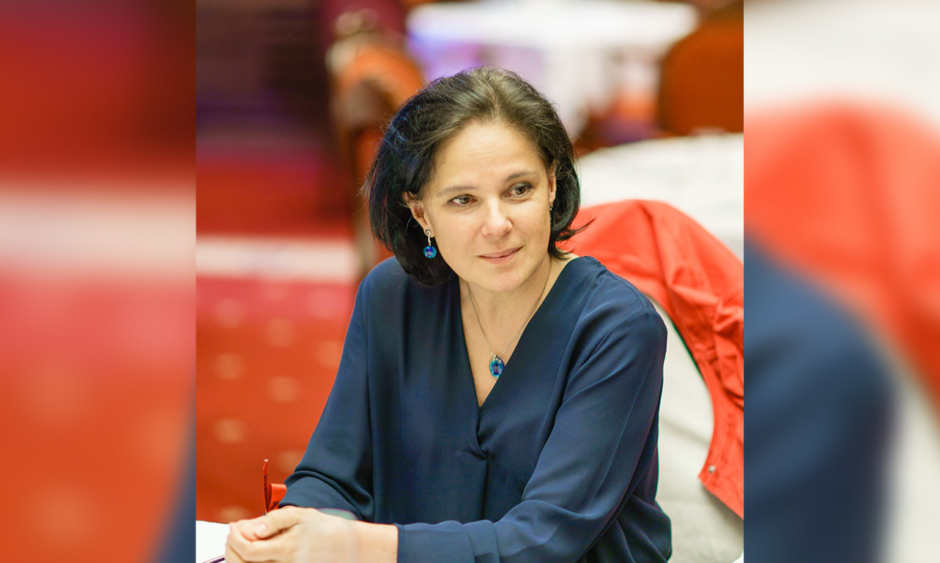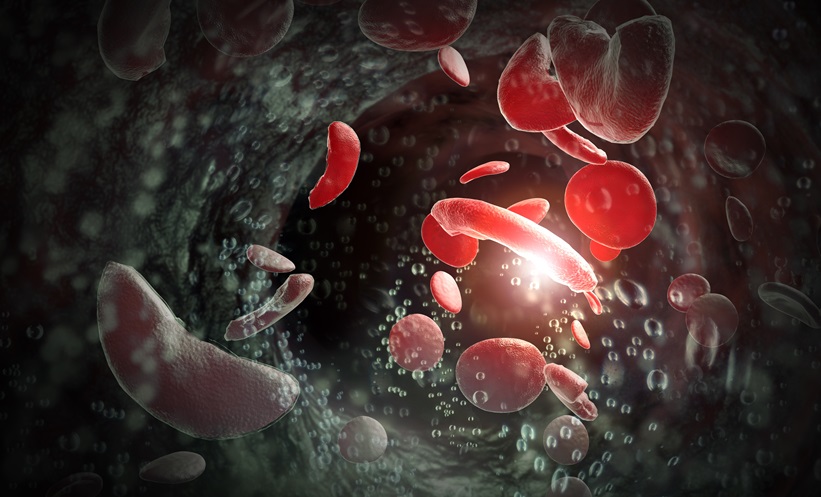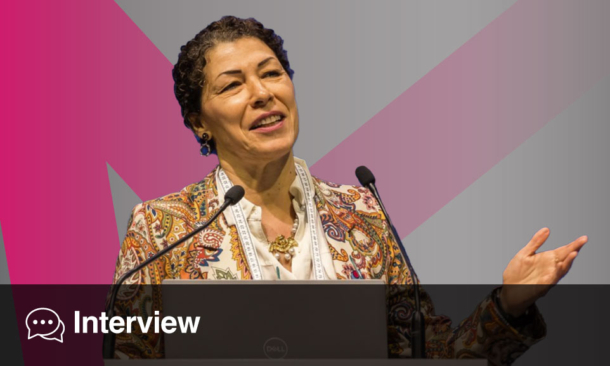Prof Margarita Guevova | EHA Chair of European Board for Accreditation in Hematology
National Specialised Hospital for Active Treatment of Haematological Diseases, Sofia, Bulgaria
![]()
You received your medical training at the Medical University of Sofia and PhD at the National Center of Hematology in 2000. What, in your opinion, are the most significant advances in haematology since this time?
These were times of innovation and change of paradigms. This refers to the outburst of novel diagnostic tests and treatments but also to a real shift of practices and processes that brought together different and new ideas in a way that significantly impacts our profession. By exciting technological innovation in research and diagnostic approaches we were able to unravel complex biological processes underlying diseases of the blood and blood-forming organs and identify many key biomarkers that allowed us to recognise entities with a distinct picture and biology and specific response options. Large-scale studies of the genome, gene expression, epigenetics, cell-to-cell interactions, and immunity changed our concepts and approaches. This came together with the development of several new molecules and targeted drugs that could more effectively treat diseases. Today, diseases that were inevitably fatal when I started my career can be successfully controlled and even cured. Furthermore, the patients may reach a life expectancy comparable to that of the general population. Unlocking and mobilising the huge potential of cells against diseases gave us powerful strategies (from transplantation to new CAR T-cell therapies). However, information and communication are the other avenues of innovation that made all this possible. Bioinformatics is an unimaginable tool for effective data analysis and novel applications; however, transfer of information and communications has allowed us to take big steps in professional community awareness, cooperation, and collaboration. Last but not least, for me personally the shift from expert-centred haematology towards an integrated multidisciplinary approach is an exciting and expiring professional environment which will be to the benefit of our patients.
By what means do you stay up to date with the latest cutting-edge advancements in haematology?
I am happy to live in times that provide us with multiple information channels. Scientific journals remain one of the major portals for gaining new information; however, nowadays with online access and means to select articles on particular topics it is amazing how you can get a comprehensive in-depth view in a short time. I have subscribed to several online channels for haematology updates as well. In addition, coming from eastern Europe I am happy to live during times when the world became more accessible to us in various aspects. Personal contact with colleagues from all over the world allowed me not only to be aware of the advances made but to comment on specific issues and to find the best ways to implement them in our practice as well. Attending meetings and conferences is a way to expose me to the latest breakthroughs and gives me opportunities for interaction. Unfortunately, the COVID-19 pandemic showed us how vulnerable we are and in one go took away these valuable personal contacts. Yet living in modern times, our communication did not stop and we saw the power of new information channels including webcasts, video conferences, and plenty of publications that keep us informed and connected. Now we can also appreciate the advantages of online training where the latest advancements can be so rapidly incorporated and accessible to anyone, no matter the location.
You were editor for a recently published ebook titled ‘Hematology: latest research and clinical advances.’ What approach do you take towards ensuring the highest possible quality in the educational materials you collaborate on?
Together with my colleague Prof Gueorgui Balatzenko, we edited a couple of haematology books, including ‘Hematology: latest research and clinical advances.’ Each chapter was a separate publication that reflected views and concepts of authors coming from different countries and professional backgrounds. The challenge was to integrate them in a useful book with examples of novel insights in our current understanding of the biology and clinical presentation, risk assessment, and therapeutic challenges in specific haematological diseases. We put in a lot of effort to develop a clear and easy to read text. Our goal was that each chapter contributed with a comprehensive and concise update in the rapidly evolving field and the content was relevant and interesting for specialists involved in the clinical management and experimental research in haematological diseases. As expected, malignancies were well covered; however, benign aspects of haematology were also present in this book with some hot topics such as the new therapies improving the outlook of bleeding and clotting disorders, as well as sickle cell disease, which 1 year later became one of the topics-in-focus of EHA. Major principles we followed in the editorial process were relevance, lack of bias, and integrity.
What do you believe are the biggest challenges currently facing the haematological research community?
The recent scientific breakthroughs have been amazing and created unprecedented advances in haematology. Yet, there are even more challenges for the conduct of medical research than ever. Some refer to scientific problems that must be solved. For example, from recognition and control of diseases we moved to prediction and cure in a substantial number of disorders. However, there is still no way to recognise individuals at risk and prevent the development of haematological malignancies. Hopefully, we are on the verge of the next paradigm shift (from ‘reactive’ to ‘preventive’). New studies aiming at preventive strategies are extremely important to pave the future of effective prevention prior to successful therapy. Big data platforms are continuously identifying new and increasing numbers of potential therapeutic targets and many novel molecules are in the pipeline. However, the time for finding a new level of synergising these technologies has come and conceptually new models for conducting clinical trials are needed, where margins between disciplines will blur. Computational biology and science, mathematics, physics, and engineering are gaining prevalence in the field. More than ever, collaboration and a multidisciplinary approach are the key for success.
However, there are other categories of challenges that may be far more difficult to overcome. There is a general concern about the increasing gap between the escalating costs of research and the access of academic institutions to funding sources that will allow them to conduct independent studies and prevent inappropriate financial influences. Centralisation and increasing bureaucracy constrain scientists’ creativity. Inequalities in access to research funds or networks, both between countries and between institutions, can lead to a disregard for the diversity of ideas needed for progress. Given the increasing pace of scientific development and the lack of a sufficient number of physicians and scientists can also be a limiting factor in ensuring that science becomes a reality and innovation is put into practice, contributing to the transformation and improvement of people’s lives.
Scientific integrity, independence of research, equality, high ethical standards, and ongoing professional development should remain the norm and enlighten the future of haematology science.
On top of your duties with the EHA, you have held roles within the Bulgarian Society of Hematology. Has advocating haematological excellence in your home region always been a passion of yours?
The Bulgarian Society of Hematology has been the home of my efforts for many years, including my early haematology career. For two terms (2011–2019) I was President and these were years devoted to the major goals defined by the Board: excellence and increased prestige of haematology. We accomplished important achievements during this period that I am very happy about. The society developed a medical standard in haematology approved by the Ministry of Health as well as the regularly updated national guidelines for diagnosis, prevention, and treatment of haematological diseases. Our activities contributed to the enhancement of the role and the importance of the discipline and further improved the dialogue and relationships with health authorities in order to achieve higher levels of medical care for patients with blood diseases. A major objective of the society is to unite and assist our members working in the field of haematology and to create conditions for their professional development. In particular, we assist young residents and specialists by providing training and continuous education. We were successful in establishing working groups (chronic lymphocytic leukaemia and lymphoma, plasma cell disorders, myeloproliferative neoplasms and myelodysplastic syndromes, anaemia, and haemorrhagic disorders, haematopoietic stem cell transplantation, Gaucher’s disease, and laboratory diagnosis) that developed guidelines and conducted nationwide studies on the epidemiology and major clinical and laboratory features of haematological entities. We have placed the young generation in the focus for the last years. We tailored our activities using surveys amongst young haematologists to investigate their attitudes. I am proud that a national symposium for trainees and young specialists has been set as a regular yearly activity that provides both education and a platform for their own presentations. Finally, a significant effort has been put to strengthen the relationships with the family of European haematology societies and the EHA. Now, the new board of the society can rely on the previous experience and receive all my support.
You are the current Chair of the EHA European Board for Accreditation in Hematology (EBAH), a position that rotates every 2 years; what element of the role do you enjoy the most?
I value the interaction with haematologists coming from different countries and various haematological fields united by the common understanding of quality, value, integrity, and dedication in continuous education of medical specialists. I enjoy the discussions and debates, the brain storming, and the chaos followed by the sudden well-defined solutions. Furthermore, I like the ease of becoming friends.
Please elucidate to our readers the primary goals that the Board is currently working towards. How will these goals be achieved?
The mission of EBAH is to stimulate and support harmonised high-quality continuous medical education in haematology, both for individuals and organisations, in order to provide the highest possible standard of patient and public healthcare within Europe. Continuing medical education/continuing professional development (CME-CPD) is widely accepted to encourage individual practitioners to maintain and develop professional knowledge and skills to keep up to date with latest developments within the field. When spending valuable time on training activities, it is essential to ensure that one is attending a high-quality educational programme. EBAH has been established as an independent accreditation body in response to this need. Our plan at present comprises several main goals: 1) to develop and implement standards and guidelines for CME-CPD activities; 2) to receive legitimacy and quality assurance through external review and mutual agreement with other accreditation bodies; 3) to gain further awareness and recognition through national and international authorities and haematology organisations; 4) to foster interactions and collaborations in CME-CPD accreditation practice and; 5) to provide accreditation for unbiased and transparent education in haematology after strict reviewing and to consider the highest quality standards and maintain a CME users platform.
I am pleased to announce that last month we uploaded a brand new ‘EBAH standards and guidelines for CME-CPD activity accreditation’ as well as ‘EBAH standards and guidelines for CME-CPD provider accreditation” on our website.1 Education organisers can find useful recommendations that will allow them to improve and receive accreditation. In addition, EBAH may award accreditation to highly reputable scientific and medical associations and societies as education providers after strict reviewing and monitoring if they consistently show that they follow the standards and meet the requirements for delivering independent CME-CPD that accelerates learning, change, and improvement in healthcare. We see EBAH accreditation as an important quality stamp for activities that benefit and develop haematology and related fields.
In terms of awareness and recognition, EBAH relies on the representation of the major international organisations in the field of haematology in the board composition: EHA, International Society of Transfusion Medicine (ISTM), International Society on Thrombosis and Haemostasis (ISTH), European Society for Bone Marrow Transplantation (EBMT), and the EBMT Nurses Group. Further interaction with national European haematology societies is foreseen.
What are some of the biggest challenges towards effective accreditation in the European haematology field, and how is the Board meeting these challenges?
There are several levels of challenges for accreditation of CME-CPD programmes regardless of the medical specialty. A major problem is that there are no specific legal or legislative mandates for CME-CPD accreditation on the European international level. CME-CPD accreditation has emerged as another example of professional self-regulation. However, the lack of clarity or pan-European regulations challenges the implementation of international principles and rules that would be recognised by both European accreditors and national regulators and would serve the individual physicians. In an attempt to find solutions, we are active in communication with other accreditation bodies in Europe and worldwide. EBAH is one of the founders of Continuing Medical Education-European Accreditors (CME-EA), a non-profit association that has devoted its mission to promote harmonisation of CME-CPD accreditation as part of a quality assurance process aiming to improve physicians’ performance and patient outcomes. We agreed that fragmentation should not be the European answer to providers and learners in CME-CPD. Together we work through dialogue and consensus to set common standards and to explore means to get broad acceptance at the national level.
EBAH aims to be the reference accreditation board in Europe for unbiased and transparent CME in haematology. This means that all elements of the programme, development, design, and execution are free of any control of commercial interest and/or any other undesirable influence. However, there have been attempts by industry to be accepted by accrediting bodies as a direct provider of accredited CME-CPD. Such a move would open the door to the introduction of an inevitable bias in CME-CPD using framed information in life-long learning. In this regard EBAH sees its role in giving clear and transparent definitions, rigorous application of appropriate principles and rules, and being in a position to enforce its own standards. In addition, our categorical position has been featured in a set of publications and position papers authored by EBAH and collaborators from CME-EA and other European medical societies and accreditation boards.







